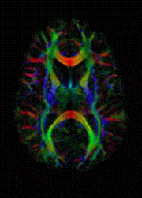
Photo from wikipedia
BackgroundPseudonormalization of diffusion-weighted magnetic resonance imaging (MRI) can lead to underestimation of brain injury in newborns with hypoxic–ischemic encephalopathy (HIE), posing a significant problem. We have noticed that some neonates… Click to show full abstract
BackgroundPseudonormalization of diffusion-weighted magnetic resonance imaging (MRI) can lead to underestimation of brain injury in newborns with hypoxic–ischemic encephalopathy (HIE), posing a significant problem. We have noticed that some neonates show pseudonormalization negativity on diffusion-weighted imaging.ObjectiveTo compare pseudonormalization negativity with clinical outcomes.Materials and methodsSeventeen term neonates with moderate or severe HIE underwent therapeutic hypothermia. They were examined by MRI twice at mean ages of 3 days and 10 days. We evaluated the presence of restricted diffusion, and also the presence or absence of pseudonormalization, by diffusion-weighted imaging at the time of the second MRI, and correlated the results with clinical outcome.ResultsDWI demonstrated no abnormality in seven neonates. Among the 10 neonates with abnormal diffusion-weighted imaging findings, 2 were positive for pseudonormalization and 8 were negative. Among neonates with normal diffusion-weighted imaging findings and with positivity for pseudonormalization, none had major disability. Among the eight neonates with pseudonormalization negativity, all but one, who was lost to follow-up, had major disability.ConclusionAbnormal diffusion-weighted imaging with pseudonormalization negativity might be predictive of severe brain injury and major disability. The second-week MRI is important for the judgment of pseudonormalization.
Journal Title: Pediatric Radiology
Year Published: 2018
Link to full text (if available)
Share on Social Media: Sign Up to like & get
recommendations!